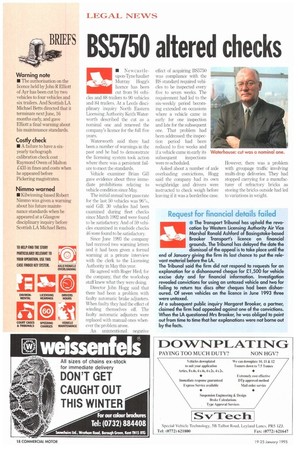BS5150 altered checks
Page 20

If you've noticed an error in this article please click here to report it so we can fix it.
• Newcastleupon-Tyne haulier Murray liogg's licence has been cut from 94 vehicles and 88 triflers to 90 vehicles and 84 tmilei s, At a Leeds disciplinary inqu ry North Eastern Licensing Authority Keith Waterworth described the cut as a nominal one and renewed the company's licence for the full five years.
Waterworth said there had been a number of warnings in the past and he had to demonstrate the licensing system took action where there was a persistent failure to meet the standards.
Vehicle examiner Brian Gill gave evidence about three immediate prohibitions relating to vehicle condition since May.
The initial annual test pass rate for the last 50 vehicles was 96%, said Gill: 30 vehicles had been examined during fleet checks since March 1992 and were found to be satisfactory. And of 59 vehicles examined in roadside checks 46 were found to be satisfactory.
Since June 1993 the company had received two warning letters and it had been given a formal warning at a private interview with the clerk to the Licensing Authority in May this year.
He agreed with Roger Hird, for the company, that the workshop staff knew what they were doing.
Director John Hogg said that there had been a problem with faulty automatic brake adjusters. When faulty they had the effect of winding themselves off. The faulty automatic adjusters were replaced with manual ones when ever the problem arose.
An unintentional negative effect of acquiring BS5750 was compliance with the BS standard required vehicles to be inspected every five to seven weeks. The requirement had led to the six-weekly period becoming extended on occasions where a vehicle came in early for one inspection and late for the subsequent one. That problem had been addressed: the inspection period had been reduced to five weeks and if a vehicle came in early its subsequent inspections were re-scheduled.
Asked about a number of axle overloading convictions, Hogg said the company had its own weighbridge and drivers were instructed to check weigh before leaving if it was a borderline case.
However, there was a problem with groupage traffic involving multi-drop deliveries. They had stopped carrying for a manufacturer of refractory bricks as storing the bricks outside had led to variations in weight.




























































































